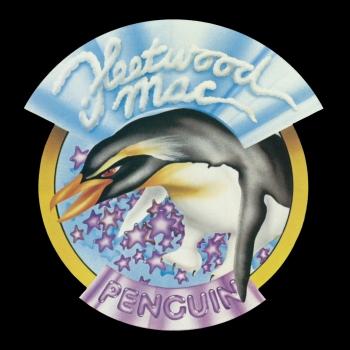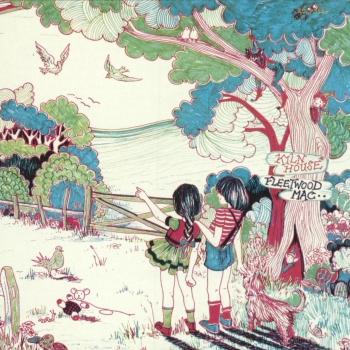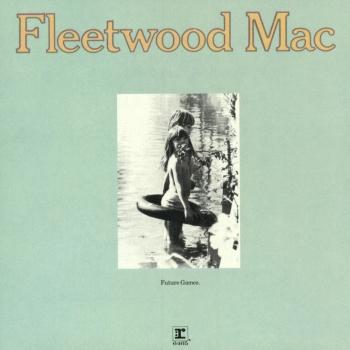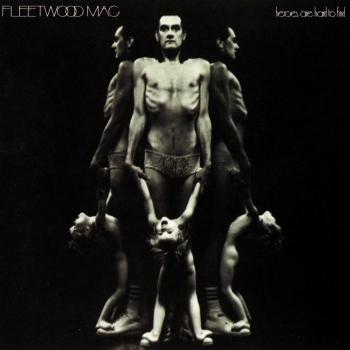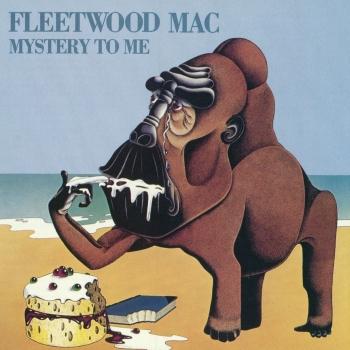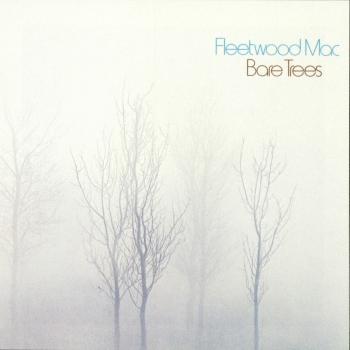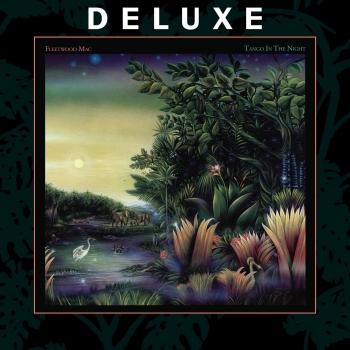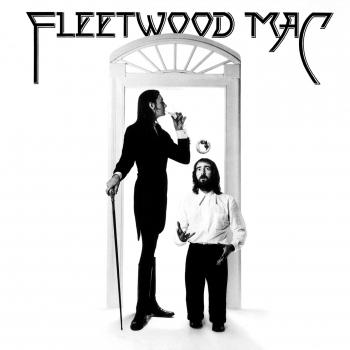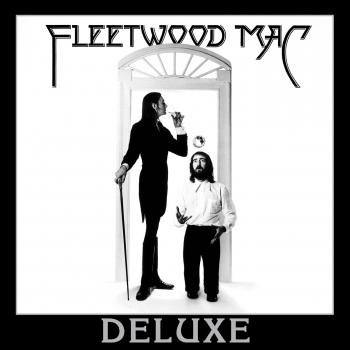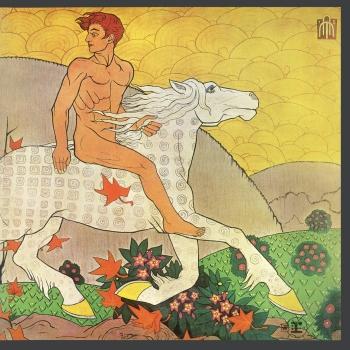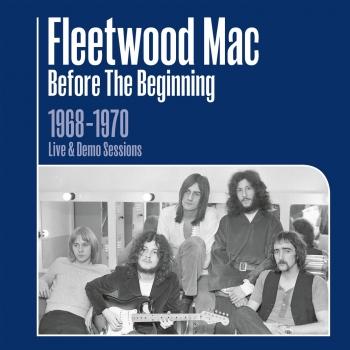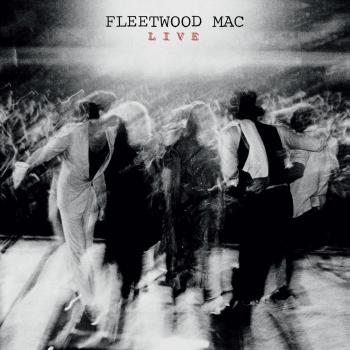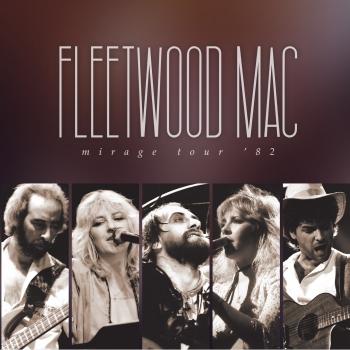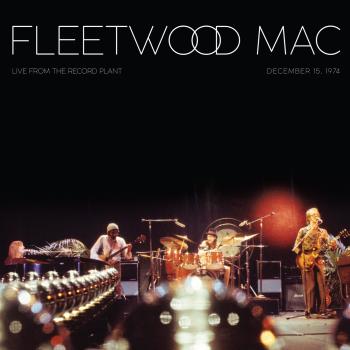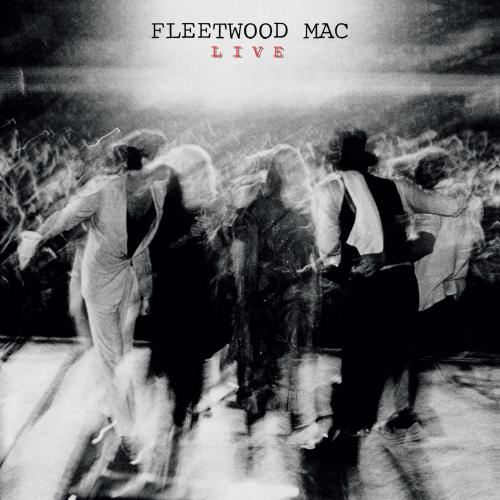
Live (Remastered) (Deluxe Edition) Fleetwood Mac
Album Info
Album Veröffentlichung:
2021
HRA-Veröffentlichung:
09.04.2021
Das Album enthält Albumcover
Entschuldigen Sie bitte!
Sehr geehrter HIGHRESAUDIO Besucher,
leider kann das Album zurzeit aufgrund von Länder- und Lizenzbeschränkungen nicht gekauft werden oder uns liegt der offizielle Veröffentlichungstermin für Ihr Land noch nicht vor. Wir aktualisieren unsere Veröffentlichungstermine ein- bis zweimal die Woche. Bitte schauen Sie ab und zu mal wieder rein.
Wir empfehlen Ihnen das Album auf Ihre Merkliste zu setzen.
Wir bedanken uns für Ihr Verständnis und Ihre Geduld.
Ihr, HIGHRESAUDIO
- 1 Monday Morning (Live at Budokan Hall, Tokyo, Japan 2/3/80) 04:00
- 2 Say You Love Me (Live at Kansas Coliseum, Wichita, KS 8/25/80) 04:16
- 3 Dreams (Live at Palais de Sport, Paris, France 6/14/80) 04:20
- 4 Oh Well (Live at Checker Dome, St. Louis, MO 11/5/79) 03:22
- 5 Over & Over (Live at Myriad, Oklahoma City, OK 8/22/80) 05:22
- 6 Sara (Live at Checker Dome, St. Louis, MO 11/5/79) 07:03
- 7 Not That Funny (Live at Richfield Coliseum, Cleveland, OH 5/21/80) 08:59
- 8 Never Going Back Again (Live at McKale Center, Tucson, AZ 8/28/80) 04:19
- 9 Landslide (Live at Wembley Arena, London, UK 6/25/80) 04:53
- 10 Fireflies (Live at Santa Monica Civic Auditorium, Santa Monica, CA 9/4/80) 04:36
- 11 Over My Head (Live at Kemper Arena, Kansas City, MO 8/24/80) 03:28
- 12 Rhiannon (Live at Wembley Arena, London, UK 6/26/80) 07:47
- 13 Don't Let Me Down Again (Live at Capitol Theater, Passaic, NJ 10/17/75) 03:57
- 14 One More Night (Live at Santa Monica Civic Auditorium, Santa Monica, CA 9/3/80) 03:45
- 15 Go Your Own Way (Live at Richfield Coliseum, Cleveland, OH 5/21/80) 05:50
- 16 Don't Stop (Live at Palais de Sport, Paris, France 6/14/80) 03:54
- 17 I'm So Afraid (Live at Richfield Coliseum, Cleveland, OH 5/20/80) 08:32
- 18 The Farmer's Daughter (Live at Santa Monica Civic Auditorium, Santa Monica, CA 9/4/80) 02:31
- 19 Second Hand News (Live at The Forum, Inglewood, CA 10/21/82) 03:52
- 20 The Chain (Live at Richfield Coliseum, Cleveland, OH, 5/20/80) 06:50
- 21 Think About Me (Live at Kemper Arena, Kansas City, MO 8/24/80) 03:09
- 22 What Makes You Think You're The One (Live at Kemper Arena, Kansas City, MO 8/23/80) 04:20
- 23 Gold Dust Woman (Live at The Forum, Inglewood, CA 8/29/77) 07:23
- 24 Brown Eyes (Live at The Forum, Inglewood, CA 10/22/82) 04:27
- 25 The Green Manalishi (With The Two-Pronged Crown) (Live at State Fair Arena, Oklahoma City, OK 5/18/77) 05:27
- 26 Angel (Live at Richfield Coliseum, Cleveland, OH 5/20/80) 04:49
- 27 Hold Me (Live at The Forum, Inglewood, CA 10/21/82) 04:19
- 28 Tusk (Live at Kemper Arena, Kansas City, MO 8/24/80) 06:25
- 29 You Make Loving Fun (Live at BOK Center, Tulsa, OK 5/19/77) 04:44
- 30 Sisters Of The Moon (Live at Omaha Civic Auditorium, Omaha, NE 8/21/80) 07:17
- 31 Songbird (Live at Omaha Civic Auditorium, Omaha, NE 8/21/80) 04:14
- 32 Blue Letter (Live at Barton Coliseum, Little Rock, AR 5/20/77) 04:48
- 33 Fireflies (Long Version) (Remix) 04:04
Info zu Live (Remastered) (Deluxe Edition)
Als Fleetwood Mac im Dezember 1980 ihr erstes Livealbum veröffentlichten, fing es die Band in ihrem ikonischsten Line-up ein, das auf der Bühne die komplette Bandbreite seiner gebündelten Kreativkräfte unter Beweis stellte. Aufgenommen größtenteils währen der Welttournee zu Tusk, war Fleetwood Mac Live ein Doppelalbum voll berauschender Performances, darunter gewaltige Hits wie „Dreams” und „Go Your Own Way”, „Rhiannon” und „Don’t Stop”.
Rhino verschafft diesem Live-Debüt der Band nun eine hochverdiente Zugabe mit einer remasterten Version des Originalalbums and HighResAudio, ergänzt um unveröffentlichter Livemusik, die zwischen 1977 und 1982 aufgenommen wurde.
„Damals wie heute markiert Fleetwood Mac Live eine faszinierende Phase für eine Band, die – auf die eine oder andere Weise – seit mehr als einem Jahrhundert auf der Weltbühne ist... Es ist ein ungemein unterhaltsamer Rock’n’Roll-Zirkus, der unter einem großen, von der Band selbst erschaffenen Zelt in vollem Gange ist und das Publikum allerorten staunend zurücklässt, von Paris, Frankreich bis nach Passaic, New Jersey. – David Wild
Der Großteil des Doppelalbums wurde zwischen 1979 und 1980 live aufgenommen, mit einigen wenigen Ausnahmen: „Don’t Let Me Down Again” wurde 1975 während der Tour zu Fleetwood Mac aufgenommen, „Dreams” und „Don’t Stop” stammen vom Soundcheck der Band in Paris, „Fireflies”, „One More Night” und ein Cover von The Beach Boys’ „Farmer’s Daughter” wurden während eines speziellen Konzertes in Kalifornien für die Crew, Familien und Freunde der Band mitgeschnitten.
"Diese Live Deluxe Version aus dem Jahre 1980 präsentiert Fleetwood Mac auf dem Höhepunkt ihrer ersten Platin-Popularität mit solchen Dauerbrennern wie "Don't Stop", "Dreams", "Say You Love Me", "Rhiannon", "Go Your Own Way", "Over My Head", "Monday Morning" und "Sara". Die energiegeladenen Aufführungen der Band geben diesem vertrauten Material einen neuen Dreh. An anderer Stelle zieht die Band mit Leichtigkeit einige Asse aus dem Ärmel, wie Lindsey Buckinghams imposante Blues-Bearbeitung der Mac-Melodie (aus der Peter Green Epoche) "Oh Well" und eine muntere, harmonische Variante von "Farmer's Daughter" der Beach Boys." (Scott Schinder)
Fleetwood Mac
Digitally remastered
Fleetwood Mac
The Fleetwood Mac story is an episodic saga that spans more than 30 years. It is the saga of a British blues band formed in 1967 that became a California-based pop group in the mid-Seventies. In between came a period where Fleetwood Mac shuffled personnel and experimented with styles, all the while releasing solid albums that found a loyal core audience. Despite all the changes, two members have remained constant over the years: drummer Mick Fleetwood and bassist John McVie, whose surnames provided the group name Fleetwood Mac. Though most rock fans are familiar with the lineup that includes Lindsey Buckingham and Stevie Nicks-by far the longest-running edition of the band, responsible for the classic albums Fleetwood Mac and Rumours-the group possesses a rich and storied history that predates those epics. Earlier Fleetwood Mac lineups included guitarists Peter Green, Jeremy Spencer, Danny Kirwan and Bob Welch. Fleetwood Mac when Green, Fleetwood and McVie, who were all expatriates from British bandleader John Mayall’s Bluesbreakers, decided to form a band. McVie and Fleetwood had been playing with Mayall, a British blues legend, since 1963 and 1965, respectively, while Green replaced Eric Clapton (who exited to form Cream) in 1966. Initially a quartet, the original Fleetwood Mac also included guitarist Jeremy Spencer and then expanded with the addition of Danny Kirwan prior to their second album. Not surprisingly, the group’s first two U.K. albums-Fleetwood Mac (1967) and Mr. Wonderful (1967)-were heavily blues-oriented. “Black Magic Woman,” a Peter Green song from the latter album, later became a major hit for Santana. In 1969, Fleetwood Mac recorded at Chess studios with American blues musicians, including Willie Dixon and Otis Span; it was released as the two-volume Blues Jam in the U.K. and as Fleetwood Mac in Chicago in the U.S. By decade’s end, however, Fleetwood Mac had begun moving from traditional blues to a more progressive approach. Around this time, the group adopted its distinctive “penguin” logo, based on zoo-lover and amateur photographer McVie’s interest in the birds. There are arguably three “definitive” Fleetwood Mac lineups. One of them is the blues-oriented band of the late Sixties, which arrayed three guitarists (Green, Spencer and Kirwan) around the rhythm section of Fleetwood and McVie. They are best represented by 1969’s Then Play On, a milestone in progressive blues-rock. After Green’s exodus in mid-1970, the remaining members cut the more easygoing, rock and roll-oriented Kiln House. Early in 1971, a born-again Spencer abruptly left the band during a U.S. tour to join the Children of God. The second key configuration found Fleetwood, McVie and Kirwan joined by keyboardist Christine McVie (born Christine Perfect, she’d married bassist McVie) and guitarist Bob Welch, a Southern Californian who became the group’s first American member and a harbinger of new directions. This configuration produced a pair of ethereal pop masterpieces, Future Games (1971) and Bare Trees (1972). Kirwan, who was having personal problems, was asked to leave in August 1972. The remaining foursome, joined by new recruits Dave Walker (vocals) and Bob Weston, recorded Penguin (1973); sans Walker, they cut Mystery to Me (1974). Again reduced to a quartet with Weston’s departure, they released Heroes Are Hard to Find later that same year. Finally, the platinum edition of Fleetwood Mac came together in 1975 with the recruitment of Lindsey Buckingham and Stevie Nicks. The San Francisco duo had previously cut an album together as Buckingham-Nicks. Drummer Fleetwood heard a tape of theirs at a studio he was auditioning, and the pair were drafted into the group without so much as a formal audition. This lineup proved far and away to be Fleetwood Mac’s most durable and successful. In addition to the most solid rhythm section in rock, this classic lineup contained strong vocalists and songwriters in Buckingham, Nicks and Christine McVie. Male and female points of view were offered with unusual candor on the watershed albums Fleetwood Mac (1975) and Rumours (1977). Fleetwood Mac introduced the revitalized group with such sparkling tracks as “Over My Head,” Fleetwood Mac’s first-ever Top Forty single; “Rhiannon,” which became Nicks’ signature song; “Say You Love Me,” which showed of the group’s three-part harmonies; and “Monday Morning,” the driving album opener and FM-radio favorite. Rumours was written and recorded as three long-term relationships-between Buckingham and Nicks, the married McVies, and Fleetwood and his wife-publicly unraveled. The album is a virtual document of romantic turmoil, and its timing reflected the interpersonal upheavals of the liberated Seventies. Resonating with a mass audience like no other album in rock history, Rumours yielded a bumper crop of songs with enduring appeal, among them the Top Ten hits “Go Your Own Way,” “Dreams,” “Don’t Stop” and “You Make Loving Fun.” Fleetwood Mac toured for seven months behind Rumours and reigned as the most popular group in the world. Rumours has to date sold 18 million copies, making it the fifth best-selling album of all time. As a group, Fleetwood Mac has sold more than 70 million albums since its inception in 1967. Under the creative guidance of Lindsey Buckingham, whose skill as a producer and pop visionary became increasingly evident-Fleetwood Mac grew more emboldened with the double album Tusk, released in 1979. A more experimental album, Tusk didn’t match its predecessors sales, but it did earn two more Top Ten hits-"Sara" and “Tusk"-while extending the group’s longevity by forswearing formulas. Solo careers commenced during the three-year layoff that followed another extensive tour. Stevie Nicks, in particular, nurtured a career that rivaled Fleetwood Mac’s for popularity. Fleetwood Mac released two studio albums in the Eighties-Mirage (1982) and Tango in the Night (1987)-but its front-line members were increasingly drawn to their solo careers. Disinclined to tour, Buckingham announced he was leaving Fleetwood Mac shortly after Tango in the Night. He was replaced by guitarists Billy Burnette and Rick Vito, who appeared on the 1990 album Behind the Mask. Eventually, both Nicks and Christine McVie revealed they, too, would no longer tour with Fleetwood Mac. Nicks officially left the band a month after Fleetwood Mac regrouped to perform “Don’t Stop” at President Bill Clinton’s inauguration in January 1993. The indefatigable core of Fleetwood and the McVies recruited guitarist Dave Mason and singer Bekka Bramlett, but the proverbial link in Fleetwood Mac’s chain had been broken one too many times and this lineup’s one album, Time (1995), fared poorly. Then, in 1997, Fleetwood Mac’s classic lineup set aside their differences for a reunion that marked the 30th anniversary of the original group’s founding and the 20th anniversary of Rumours’ release. A concert was filmed for an MTV special and saw release on video and audio formats as The Dance, which found the group revisiting old material and premiering new songs. A full-fledged reunion tour followed.
Dieses Album enthält kein Booklet










